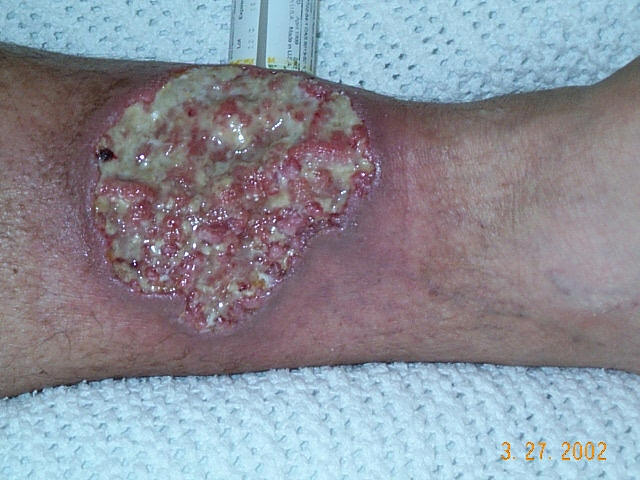Pyoderma Gangrenosum

Pyoderma gangrenosum (PG) is a primarily sterile inflammatory neutrophilic dermatosis characterized by recurrent cutaneous ulcerations with a mucopurulent or hemorrhagic exudate.
Epidemiology
The exact prevalence of PG is unknown. The incidence has been estimated to range between 1 and 3.3 in 330,000. The incidence peak occurs between the ages of 20 to 50 years, with women being more often affected than men.
Clinical description
Clinically, onset occurs with sterile pustules that rapidly progress and turn into very painful ulcers of variable depth and size, with undermined bluish or violaceous borders and surrounding erythema. The legs are most commonly affected but other parts of the skin and mucous membranes may also be involved. The clinical course can be mild or malignant, chronic or relapsing with significant morbidity. In many cases, PG is associated with an underlying disease, most commonly inflammatory bowel disease, rheumatic or hematological disease, or malignancy.
Etiology
The etiology has not yet been clearly determined.
Diagnostic methods
Diagnosis of PG is based on the history of the underlying disease, typical clinical presentation, histopathology, and exclusion of other diseases that would lead to a similar clinical picture.
Management and treatment
The treatment of PG is a challenge. Randomized, double-blind prospective multicenter trials for PG are not available. The best documented treatments are systemic corticosteroids and cyclosporin A. Combinations of steroids with cytotoxic drugs are used in resistant cases. The combinations of steroids with sulfa drugs or immunosuppressants are used as steroid sparing modalities. Rapid improvement of PG has been obtained by anti-tumor necrosis alpha therapy used in Crohn's disease. Skin transplants and the application of bioengineered skin is useful in selected cases, as a complementary therapy to the immunosuppressive treatment. Topical therapy with modern wound dressings is useful to minimize pain and the risk of secondary infections.
Prognosis
Despite recent advances in therapy, the prognosis of PG remains unpredictable.